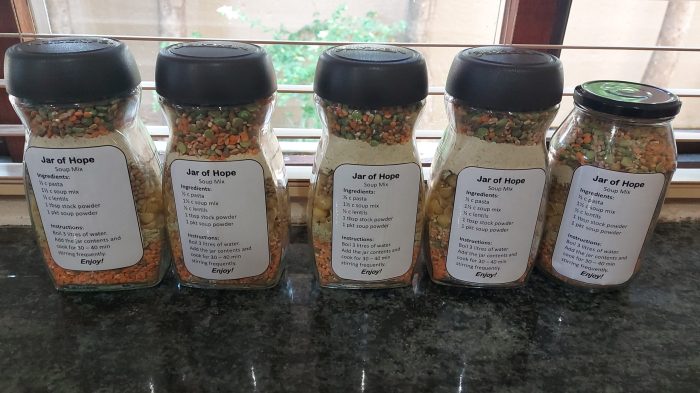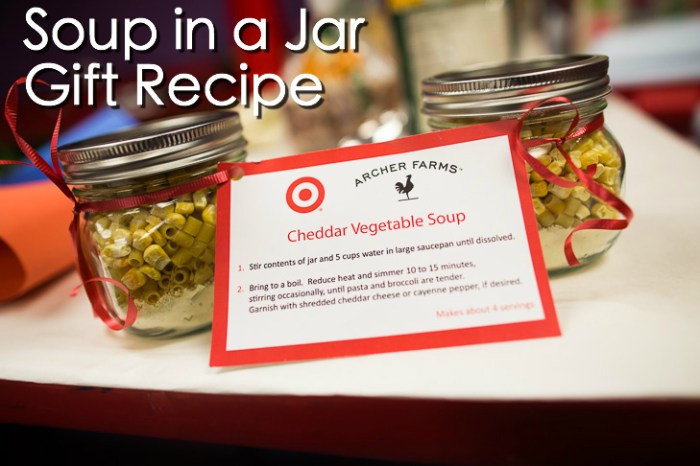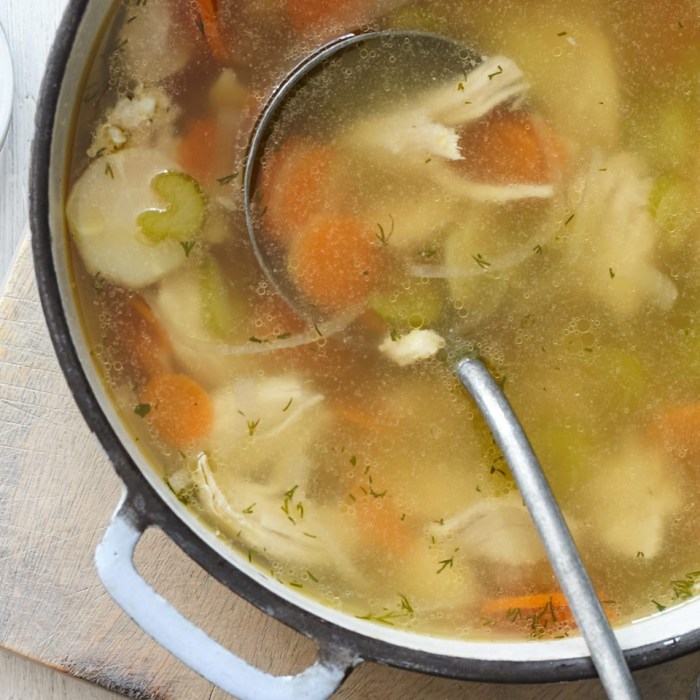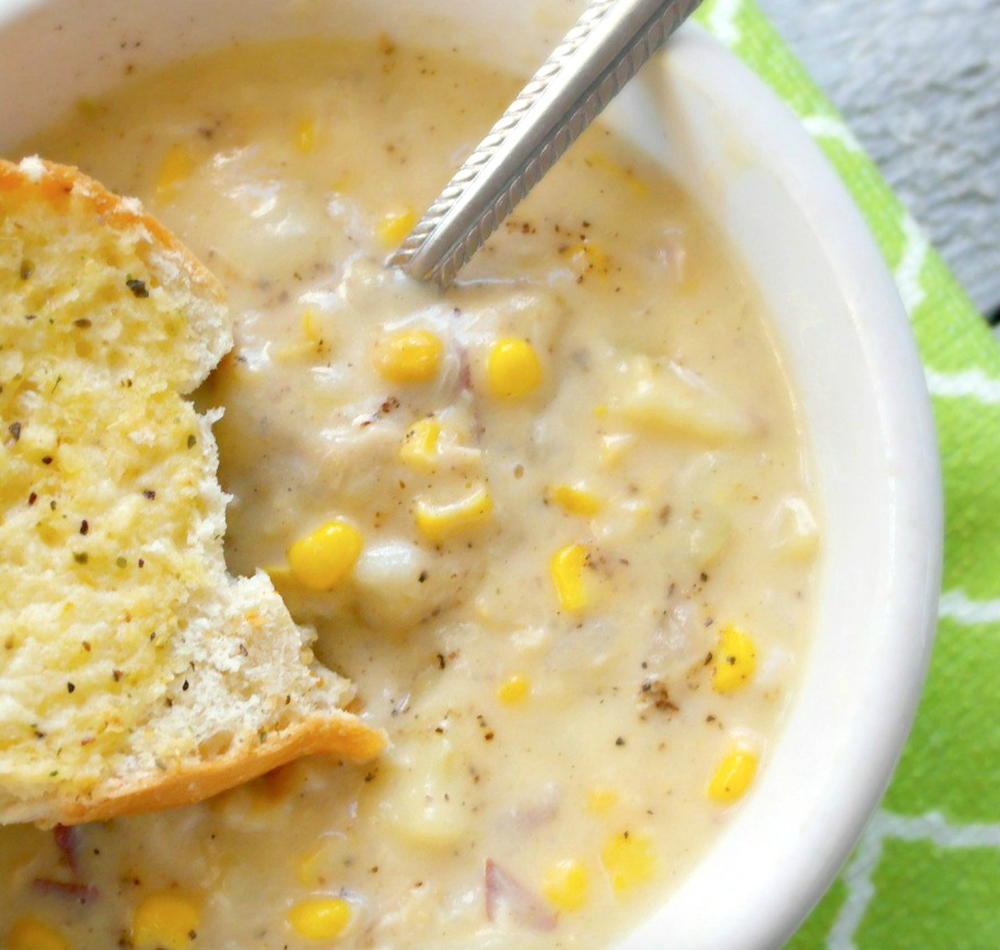Soup in a Jar Recipes: A Convenient and Flavorful Meal Prep Solution
Soup in a jar recipes offer a delightful blend of convenience and culinary creativity. The method simplifies meal preparation, allowing for efficient batch cooking and easy storage. This approach is ideal for busy individuals or those seeking a healthy and delicious alternative to traditional takeout or processed meals. The following sections will explore the various aspects of creating, storing, and enjoying homemade jarred soups.
Introduction to Soup in a Jar Recipes

Source: co.za
The appeal of soup in a jar recipes lies in their ease of preparation and long shelf life. Meal prepping with this method significantly reduces time spent cooking during the week. Simply grab a jar from the pantry, heat, and enjoy a nutritious and satisfying meal. Proper storage is key to maintaining the quality and safety of jarred soups; refrigeration or proper canning techniques are crucial to ensure a longer shelf life, typically ranging from several days to several months depending on the method used.
Recipe Variety and Customization
The versatility of soup in a jar recipes is virtually limitless. From hearty vegetable soups to creamy tomato bisques, the possibilities are endless. The following table provides examples of diverse soup types suitable for jarring, highlighting their unique ingredient profiles and flavor combinations.
| Soup Type | Main Ingredients | Seasoning Suggestions | Preparation Notes |
|---|---|---|---|
| Vegetable Soup | Carrots, celery, potatoes, peas, green beans, broth | Bay leaf, thyme, rosemary, black pepper | Sauté vegetables before adding broth for deeper flavor. |
| Lentil Soup | Red or green lentils, carrots, celery, onion, broth | Cumin, coriander, turmeric, garlic powder | Simmer lentils until tender before jarring. |
| Chicken Noodle Soup | Cooked chicken, noodles, carrots, celery, onion, broth | Parsley, thyme, salt, pepper | Cook noodles separately to prevent them from becoming mushy. |
| Tomato Soup | Crushed tomatoes, onion, garlic, vegetable broth | Basil, oregano, sugar, salt, pepper | Simmer until tomatoes are thickened. |
| Minestrone Soup | Beans, pasta, vegetables (zucchini, carrots, etc.), broth | Italian herbs, Parmesan cheese | Cook pasta separately to prevent overcooking. |
Three variations of a minestrone soup could include: a classic version with traditional Italian ingredients; a vegetarian version substituting vegetable broth for chicken broth and adding more beans; and a spicy version incorporating chili flakes and a touch of smoked paprika.
Three unique soup recipes tailored for canning include: a creamy butternut squash soup with ginger and coconut milk; a curried lentil soup with spinach and cilantro; and a hearty beef stew with potatoes, carrots, and pearl onions.
Jar Selection and Preparation
Choosing the right jars is crucial for successful canning. Mason jars, particularly wide-mouth jars, are popular due to their durability and ease of use. However, other heat-resistant glass jars are also suitable. Before filling, jars and lids must be thoroughly cleaned and sterilized to prevent contamination and ensure a proper seal. This typically involves washing in hot, soapy water, followed by a thorough rinse and sterilization using boiling water or a steam canner.
Proper sealing involves ensuring a tight fit between the lid and jar, often confirmed by a popping sound as the jar cools and creates a vacuum seal.
Soup Preparation and Layering Techniques

Source: jamonkey.com
Layering ingredients in jars is essential for maintaining optimal texture and flavor. Denser ingredients should be placed at the bottom, followed by lighter ingredients. This prevents ingredients from settling unevenly and ensures even heating during reheating. Preparing a hearty vegetable soup involves sautéing vegetables, then simmering them in broth until tender. Proper ingredient ratios depend on personal preference, but a general guideline is to use a balance of vegetables and broth.
Cooking time will vary depending on the vegetables used, but aim for tenderness without overcooking.
For a creamy tomato soup, a visual layering guide would be: First, a layer of the thicker tomato base (after simmering and thickening). Next, a layer of fresh basil leaves. Then, a layer of heavy cream or coconut cream (depending on the desired richness and dietary needs). Finally, a small amount of grated Parmesan cheese (optional) can be sprinkled on top.
This layering helps maintain the visual appeal and texture, with the cream preventing the basil from wilting and adding a luxurious finish.
Storage and Reheating, Soup in a jar recipes
Proper storage is crucial for maintaining the quality and safety of jarred soups. Store jars in a cool, dark, and dry place. Reheating can be done safely on the stovetop, in the microwave, or in the oven. For stovetop reheating, gently heat the soup in a saucepan over low heat, stirring occasionally. Microwave reheating should be done in short intervals to prevent uneven heating and potential splattering.
Oven reheating is suitable for larger batches, but ensure the jars are oven-safe. Improper storage, such as leaving jars at room temperature for extended periods, can lead to spoilage and potential bacterial growth. Always check for bulging lids or unusual smells before reheating, discarding any jars showing signs of spoilage.
Recipe Variations and Dietary Considerations
Adapting soup recipes to accommodate various dietary needs is straightforward. Vegetarian and vegan options can be easily created by substituting vegetable broth for chicken broth and using plant-based alternatives for meat or dairy products. Gluten-free options require using gluten-free pasta or noodles. Common dietary restrictions, such as dairy allergies, nut allergies, and soy allergies, can be accommodated by carefully selecting ingredients and avoiding allergenic components.
Nutritional value varies greatly depending on the ingredients used. Soups rich in vegetables offer a high concentration of vitamins and minerals, while those containing beans or lentils provide significant protein and fiber. Comparing nutritional profiles requires analyzing the specific ingredients in each recipe.
Commonly Asked Questions: Soup In A Jar Recipes
Can I freeze soup in jars instead of canning?
Soup in a jar recipes offer fantastic meal prep options, perfect for busy weeknights. If you’re looking for a hearty and flavorful base for your jarred soups, a simple yet delicious option is to start with an easy onion soup; you can find a great recipe here: onion soup recipe easy. Once you’ve made a batch, simply layer it into your jars with other vegetables and proteins for complete, ready-to-heat meals.
This ensures you always have a comforting, homemade soup readily available.
Yes, you can freeze soup in jars, but leave headspace for expansion. Use freezer-safe jars and lids.
What happens if a jar doesn’t seal properly?
A jar that doesn’t seal properly is unsafe for long-term storage. Refrigerate and consume it within a few days.
How long can I store properly sealed jarred soup?
Properly canned and stored soup can last for 12-18 months, but always check for spoilage before consumption.
Can I use regular glass jars for canning?
No, only jars specifically designed and tested for canning (like mason jars) should be used to ensure safe sealing and prevent breakage during processing.


